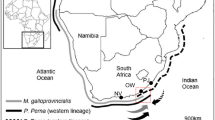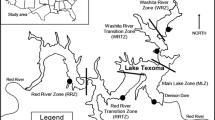Abstract
A population of the invasive musselMusculista senhousia was monitored bimonthly from May 1999 through April 2000 in the Sacca di Goro, a brackish lagoon of the Po River Delta, Northern Adriatic Sea, in order to give information on the gametogenic cycle, population dynamics, and secondary production of this successful invader. The gonad underwent 4 different stages: spent (December to February), developing (March to May), ripe (June to August), and spawning (September to November). The population was numerically dominated by a single cohort of individuals for most of the year. The mean size of this cohort rapidly increased to 24–25 mm shell length, after which growth slowed and mussels rarely grew larger than 30–32 mm. Summer anoxia may have greatly reduced mussel abundance; annual cohort mortality was 95%. No recruitment was registered on the bed until February 2000, and there was a large pulse of new recruits in April when two cohorts were clearly recognizable. The established bed was the primary site for new recruitment. Secondary production, calculated with two different methods, gave comparable estimates; P:B ratios were 1.5 and 1.7.M. senhousia beds seemed to facilitate the presence of other macrofaunal taxa: abundance of some species (a small gastropod, amphipods, and tube-building polychaetes) were significantly higher within mussel mats at two sites sampled in May 2000 than they were in soft-sediments ∼100 m away.
Similar content being viewed by others
Literature Cited
Ault, J. S. andN. M. Ehrhardt. 1991. Correction to the Beverton and Holt Z-estimator from truncated catch length-frequency distributions.ICLARM Fishbyte 9:37–39.
Bayne, B. L. 1976. Marine Mussels: Their Ecology and Physiology. Cambridge University Press, Cambridge, U.K.
Beverton, R. J. H. andS. J. Holt. 1957. On the dynamics of exploited fish populations.Fishery Investigations Series 2, 19:1–533.
Bhattacharya, C. G. 1967. A simple method of resolution of a distribution into Gaussian components.Biometrics 23:115–135.
Ceccherelli, V. U. andR. Rossi. 1984. Settlement, growth and production of the musselMytilus galloprovincialis, Marine Ecology Progress Series 16:173–184.
Cesari, P. andM. Pellizzato. 1985. Molluschi pervenuti in laguna di Venezia per apporti volontari o casuali.Bollettino Malacologico 21:237–274.
Chiba, K. 1977. On the ecology of the bivalveMusculs senhousia.Marine Sciences Monthly 9:13–17. (in Japanese with English abstract).
Clarke, K. R. andR. N. Gorley. 2001. PRIMER v5: User Manual/Tutorial. PRIMER-E Ltd., Plymouth, U.K.
Creese, R., S. Hooker, S. DeLuca, andY. Wharton. 1997. Ecology and environmental impact ofMusculista senhousia (Mollusca: Bivalvia: Mytilidae) in Tamaki Estuary, Auckland, New Zealand.New Zealand Journal of Marine and Freshwater Research 31:225–236.
Crisp, D. J. 1984. Energy flow measurements, p. 284–372.In N. A. Holme and A. D. McIntyre (eds.), Methods for the Study of Marine Benthos. Blackwell Scientific Publications, Oxford, U.K.
Crooks, J. A. 1996. The population ecology of an exotic mussel,Musculista senhousia, in a Southern California Bay.Estuaries 19: 42–50.
Crooks, J. A. 1998. Habitat alteration and community-level effects of an exotic mussel,Musculista senhousia.Marine Ecology Progress Series 162:137–152.
Crooks, J. A. 2001. Assessing invader roles within changing ecosystems: Historical and experimental perspectives on an exotic mussel in an urbanized lagoon.Biological Invasions 3:23–36.
Crooks, J. A. andH. S. Khim. 1999. Architectural vs. biological effects of a habitat-altering, exotic mussel,Musculista senhousia.Journal of Experimental Marine Biology and Ecology 240:53–75.
Dare, P. J. 1973. The stocks of young mussels in Morecombe Bay, Lancashire.Ministry of Agriculture Fisheries and Food, Shellfish Information Leaflet 28:1–14.
Ehrhardt, N. M. andJ. S. Ault 1992. Analysis of two length-based mortality models applied to bounded catch length frequencies.Transaction of the American Fisheries Society 121:115–122.
Gayanilo, F. C., P. Sparre, andD. Pauly. 1996. FAO-ICLARM stock assessment tools. Food and Agriculture Organization of the United Nations, Rome, Italy.
George, E. L. andN. B. Nair. 1974. The growth rates of the estuarine molluscMusculista arcuatula Yamamoto and Habe (Bivalvia: Mytilidae).Hydrobiologia 45:239–248.
Ghisotti, F. 1974.Rapana venosa (Valenciennes): Nuova ospite adriatica?Conchiglie 10:125–126.
Hoenselaar, H. J. andJ. Hoenselaar. 1989.Musculista senhousia (Benson in Cantor, 1842) in the Western Mediterranean (Bivalvia; Mytilidae).Basteria 53:73–76.
Kawahara, T. andD. Katou. 1970. Artificial inducement of spawning and larval development in mussel,Musculus senhousia.The Aquiculture 17:247–261.
Kulikova, V. A. 1978. Morphology, seasonal population dynamics, and settlement of larvae of the bivalve molluskMusculista senhousia, in Busse Lagoon (South Sakalin).Soviet Journal of Marine Biology 4:769–773.
Kulikova, V. A. 1979. Reproductive peculiarities of bivalve mollusks in Busse Lagoon in relation to water temperature.Soviet Journal of Marine Biology 5:25–28.
Kvalseth, T. O. 1985. Cautionary note about r2.American Statistician 39:279–285.
Lazzari, G. andE. Rinaldi. 1994. Alcune considerazioni sulla presenza di specie extra mediterranee nelle lagune salmastre di Ravenna.Bollettino Malacologico 30:195–202.
Lubet, P. andR. Mann. 1987. Les différentes modalités de la reproduction chez les mollusques bivalves.Haliotis 16:181–195.
Mack, R. andA. Occhipinti Ambrogi. 1999. Biotic invasions: A global perspective and ecology of invasion: Patterns and perspectives, p. 67–74.In A. Farina (ed.), Perspectives in Ecology. Backhuys Publishers, Leiden The Netherlands.
Matta, F. 1969. Rinvenimento diGryphaca sp. nell'Alto Adriatico.Bollettino della Pesca, Piscicoltura e Idrobiologia 24:91–96.
Mistri, M. 2002a. Persistence of benthic communities: A case study from the Valli di Comacchio, a Northern Adriatic lagoonal ecosystem (Italy).ICES Journal of Marine Science 59:314–322.
Mistri, M. 2002b. Foraging behaviour and mutual interference in the Mediterranean shore crab,Carcinus aestuarii, preying upon the immigrant musselMusculista senhousia. Estuarine, Coastal and Shelf Science in press.
Mistri, M., E. A. Fano, andR. Rossi. 2001a. Redundancy of macrobenthos from lagoonal habitats in the Adriatic Sea.Marine Ecology Progress Series 215:289–296.
Mistri, M., E. A. Fano, G. Rossi, K. Caselli, andR. Rossi. 2000. Variability in macrobenthos communities in the Valli di Comacchio, northern Italy, a hypereutrophized lagoonal ecosystem.Estuarine, Coastal and Shelf Science 51:599–611.
Mistri, M., R. Rossi, andV. U. Ceccherelli. 1988. Growth and production of the ark shellScapharca inaequivalvis in a lagoon of the Po River Delta,P.S.Z.N.I.: Marine Ecology 9:35–49.
Mistri, M., R. Rossi, andE. A. Fano. 2001b. Structure and secondary production of a soft bottom macrobenthic community in a brackish lagoon (Sacca di Goro, north-eastern Italy).Estuarine, Coastal and Shelf Science 52:605–616.
Morton, B. 1974. Some aspects of the biology, population dynamics, and functional morphology ofMusculista senhousia Benson (Bivalvia, Mytilidae),Pacific Science 28:19–33.
Morton, B. 1989. Life-history characteristics and sexual strategy ofMytilopsis sallei (Bivalvia: Dreissenacea), introduced in Hong Kong,Journal of Zoology, London 219:469–485.
Mukai, H. 1974. Ecological studies on distribution and production of some benthic animals in the coastal waters of Central Inland Sea of Japan.Journal of Science of Hiroshima University Series B 25:1–82.
Ragnarsson, S. A., andD. Raffaelli. 1999. Effects of the musselMytilus edulis L. on the invertebrate fauna of sediments.Journal of Experimental Marine Biology and Ecology 241:31–43.
Reusch, T. B. H. 1998. Native predators contribute to invasion resistance to the non-indigenous bivalveMusculista senhousia in southern California, USA.Marine Ecology Progress Series 170: 159–168.
Reusch, T. B. H. andS. L. Williams. 1998. Variable responses of native eelgrassZostera marina to a non-indigenous bivalveMusculista senhousia.Oecologia 113:428–441.
Ricciardi, A., F. G. Whoriskey, andJ. B. Rasmussen. 1997. The role of zebra mussel (Dreissena polymorpha) in structuring macroinvertebrate communities on hard substrata.Canadian Journal of Fisheries and Aquatic Sciences 54:2596–2608.
Tanaka, M. andT. Kikuchi. 1978. Ecological studies on benthic macrofauna in Tomoe Cove, Amakusa. II. Production ofMusculista senhousia (Bivalvia, Mytilidae),Publications of the Amakusa Marine Biological Laboratory 4:215–233.
Tumbiolo, M. L. andJ. A. Downing. 1994. An empirical model for the prediction of secondary production in marine benthic invertebrate populations.Marine Ecology Progress Series 114: 165–174.
Uchida, A. 1965. Growth of a musselMusculista senhousia and the influence ofMusculista senhousia on the clamTapes philippinarum.Reports of the Chiba Prefecture Inshore Fisheries Experimental Station 7:69–78. (in Japanese)
Valli, G. 1971. Ciclo di maturità sessuale diMytilus galloprovincialis Lmk. di Duino (Trieste).Bollettino della Pesca, Piscicoltura e Idrobiologia 26:259–265.
Vitousek, P. M. 1990. Biological invasions and ecosystem processes: Towards an integration of population biology and ecosystem studies.Oikos 57:7–13.
Vitousek, P. M., L. R. Walker, L. D. Whiteacre, D. Mueller-Dombois, andP. A. Matson. 1987. Biological invasion byMyrica fava alters ecosystem development in hawaii.Science 238: 802–804.
Willan, R. C. 1987. The musselMusculista senhousia in Australasia; Another aggressive alien highlights the need for quarantine at ports.Bulletin of Marine Science 41:475–478.
Yamamuro, M., N. Oka, andJ. Hiratsuka. 1998. Predation by diving ducks on the biofouling musselMusculista senhousia in a eutrophic estuarine lagoon.Marine Ecology Progress Series 174: 101–106.
Yamamuro, M., J. Hiratsuka, andY. Ishitobi. 2000. Seasonal change in a filter-feeding bivalveMusculista senhousia population of a eutrophic estuarine lagoon.Journal of Marine Systems 26:117–126.
Sources of Unpublished Materials
Cannas, A. personal communication. Centro Italiano Ricerche e Studi per la Pesca, via Isonzo 12, 09122 Cagliari, Italy.
Savarino, R. personal communication. Centro Italiano Ricerche e Studi per la Pesca, via Isonzo 12, 09122 Cagliari, Italy.
Author information
Authors and Affiliations
Rights and permissions
About this article
Cite this article
Mistri, M. Ecological characteristics of the invasive Asian date mussel,Musculista senhousia, in the Sacca Di Goro (Adriatic Sea, Italy). Estuaries 25, 431–440 (2002). https://doi.org/10.1007/BF02695985
Received:
Accepted:
Issue Date:
DOI: https://doi.org/10.1007/BF02695985




